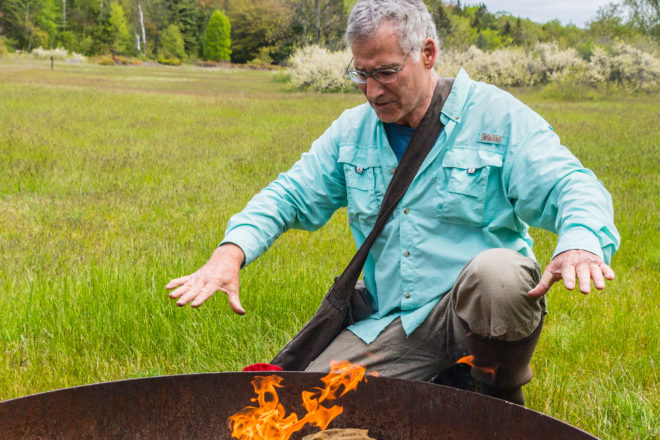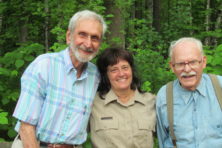How to Build A Better Campfire
- Share
- Tweet
- Pin
- Share

Now that it’s campfire season, it’s as good a time as any to revisit the fundamentals. Pulse photo director Len Villano and I spent a morning in Newport State Park with fire science expert Ken Foszcz as he walked us through fire building using gathered materials and without any Boy Scout juice. It had just rained for hours, but Foszcz got it going in no time.
What follows is a description of materials to use, where to find them, and how to shape your fire to ensure it starts roaring quickly and easily.
“You can’t pass up what’s lying around,” Foszcz said. If you’re building a fire at a campsite, then gathering materials to burn while you hike around the area is a great way to take advantage of what the area has to offer.
Three types of combustible material are needed to start a fire: flammable tinder for catching a spark, small kindling for growing a fire in its infancy, and larger firewood for sustaining the blaze.
Tinder is perhaps the most specialized material. The most common tinder used for home fires is newspaper, which you can always bring with you. If you’re scavenging, look for birch bark on fallen birch trees, milkweed pods and dry grass.
If it rained recently, find your kindling by scavenging dead twigs and sticks off of standing trees. Gather wood varying in thickness from as small as you can find to about a quarter-inch in diameter. Your kindling should be as dry as possible; it’s dry enough if, when you bend it, the stick snaps apart. Note: live wood is wet wood. It will not burn well.
Gathering your firewood also limits the spread of the emerald ash borer, an invasive insect that kills ash trees. The Wisconsin Department of Natural Resources recommends using firewood within 10 miles of where it was collected for this very reason. When you bring firewood anywhere, make sure to burn all of it; don’t leave any of it behind.
- Prepare tinder ball.
- Stoke the spark.
- Transfer the flame.
- Add kindling.
- Enjoy the fruits of your labor – a blazing campfire. Above: Fire science expert Ken Foszcz. Photos by Len Villano.
Build
“Fire likes fuel…You want everything in your favor that you can possibly do.”
The difference between a one-match fire and a 12-match fire is making sure your tinder will do its job. Your spark must not only ignite your tinder, but your tinder must also be in contact with as little non-combustible material as possible. Insulate your fire from the ground using dry wood or leftover wood (if any). This ensures that the ground, if wet or cold, won’t sap all of the heat out of your tinder as it begins to burn. Position thumb-thickness sticks in a V shape to cradle the tinder; if you can, prop them up to improve airflow.
Gather your tinder into a compact ball, ideally softball-sized. Birch bark can be used to hold it together; newspaper will do just fine as well.
Light
“Fire likes chaos.”
When starting any fire, you start with the most flammable material, then gradually increase the size of the material being used. This is especially important when using flint, which emits a small spark.
Get the tinder going. Blow on it gently to spread the flame.
Once it doesn’t need your help, set your tinder ball into your cradle and place a kindling bunch on top of it.
As your kindling catches fire, you can begin to build up your fire. Graduate to larger and larger wood, using finger-width sticks next. When they catch fire, then you can place larger logs on the fire.







